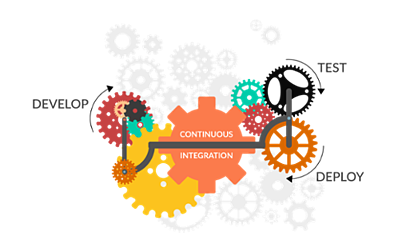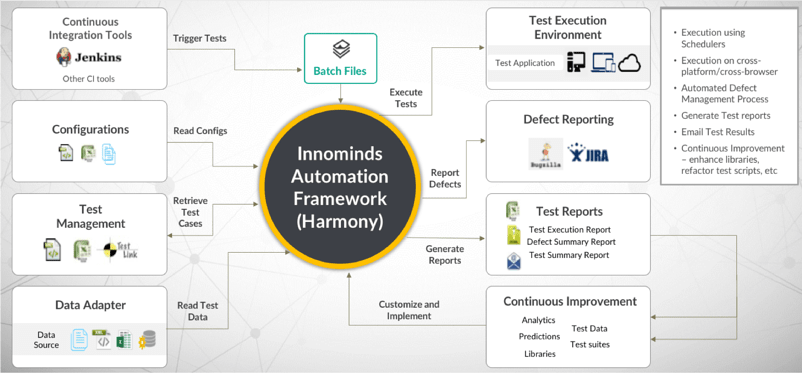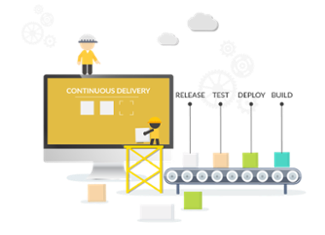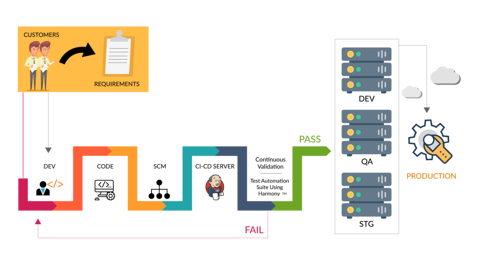Continuous Integration
Continuous Integration is a process that development teams must adopt as it encourages developers to push new code changes as and when they write it. This process is designed to trigger automatic code integration in main code base. Instead of developing in isolation and then integrating them at end of development cycle, if continuous integration process is followed, the code integrations can be done on the fly as and when there is a new code. Continuous integration process will allow developers to integrate and test their code multiple times throughout the day.

Organizations must be aware that this process of integration alone will not guarantee quality of code or its functionality. But enhancing this will address them and solve those issues. Nevertheless, in many organizations, build integration is time consuming as manual processes are used to validate adherence to coding standards. Moreover, new code does not introduce new bugs or break existing functionality. Hence, build automation in this area is needed. Build automation with a success and failure criteria will lead us to the next major phase, which is continuous validation.
Continuous Validation
Continuous validation covers white box testing and black box testing followed by additional validation criteria as per scope of verification and validation stages. To ensure such white box and black box tests, optimal validation of the success of a specific build would need effective test framework to address failure areas, pin point the code check-ins that led to failures and trace/debug mechanisms that assist development teams in fixing issues. Hence, continuous validation would help address test validation criteria at a rapid pace through parallel test methodologies in an agile world.
Another major risk mitigated by implementing continuous validation is that testing teams receive only the stable builds after sanity testing through automation. This enables testing teams to perform effective testing on a stable build.
Innominds addresses continuous validation requirements through its home-grown Framework, Harmony™. Harmony™ has several accelerators to speed up test automation development and support the continuous validation through its rich set of reusable components and advanced debug-based test reporting to pin point the code check-ins that causes the failures. Harmony™ orchestrates with CI tools like Jenkins with automated defect reporting into defect management tools like JIRA followed by test execution status updates in a test management tool like Test Link.
So, the end goal of continuous integration is to seamlessly integrate the old code with new code, which gives us stable build with enhanced features without integration and code quality issues. Continuous integration process should be simple and seamless in everyday development workflow as it will reduce integration costs and responds to bugs early. This should make the CI system robust, automated and fast while encouraging developers for frequent code integrations.
Top continuous integration tools that are available today in the market are Jenkins, Team City, Travis, Go CD, Bamboo, GitLab CI, Circle` CI and Codeship. Each of these tools has specific advantages and pricing options, which can be used to determine the needs of an organisation.

Continuous Delivery
Continuous delivery is the extension of continuous integration. Its focus is to automate the software delivery process so that teams can easily deploy code into the required environments at any given time. Continuous delivery ensure high code quality as it comes once continuous integration is completed. Teams need to combine continuous delivery with continuous integration along with continuous testing. This will give developers confidence and immediate insight into ways in which a minor code change behaves, once it is committed.
 Implementing continuous integration and continuous delivery practice requires a mixture of technical and organizational improvements to be effective. Let’s talk about technology side. Continuous delivery leans heavily on deployment of pipeline to automate the testing and deployment process. This will ensure delivery of the newly built code from development to QA for continuous and automated testing, which is pre-configured. Reliable continuous integration setup is a pre-requisite to implement continuous delivery.
Implementing continuous integration and continuous delivery practice requires a mixture of technical and organizational improvements to be effective. Let’s talk about technology side. Continuous delivery leans heavily on deployment of pipeline to automate the testing and deployment process. This will ensure delivery of the newly built code from development to QA for continuous and automated testing, which is pre-configured. Reliable continuous integration setup is a pre-requisite to implement continuous delivery.
As per the organizational structure, continuous delivery pipeline can extend to other environments like staging or pre-production where continuous automated tests run on alpha or beta releases before it can be deployed in production. Continuous delivery is attractive because it automates the steps between checking code into the repository and gives absolute confidence on releasing well-tested, functional builds to your production infrastructure.
Continuous Integration - Continuous Delivery Workflow
In general, implementation of continuous integration in development and staging environments is recommended. At some places, a manual review is required with approvals for production deployment. For production environment, we should make sure it happens when key stakeholders in development team are available for support and must be planned during low-traffic periods. In order to make sure that developers are able to check ways in which their new code changes are behaving, there should be an automated process for any development and testing environments.
Below is typical workflow

As discussed, CI-CD does not just mean code integration and deployment. It also covers code coverage tests, code quality analysis, running sanity test suite and publishing reports. All can be integrated into a single pipeline, which completes a full life cycle for continuous integration, continous validation, continuous delivery and continous deployment of applications on-premise, public, private or hybrid clouds.
Innominds is a dedicated product incubator for technology industry clients seeking help with Design, Technology and Quality Engineering solutions across all stages of their product life cycle. We have deep expertise in Quality Engineering with extensive experience in setting up dedicated and secured Offshore Development / Test Centers with replicated client environments for technology companies and Enterprises, ensuring Quality @ Speed.
Interested! For any demos or POCs, please write to us at marketing@innominds.com and know more about our offerings.




